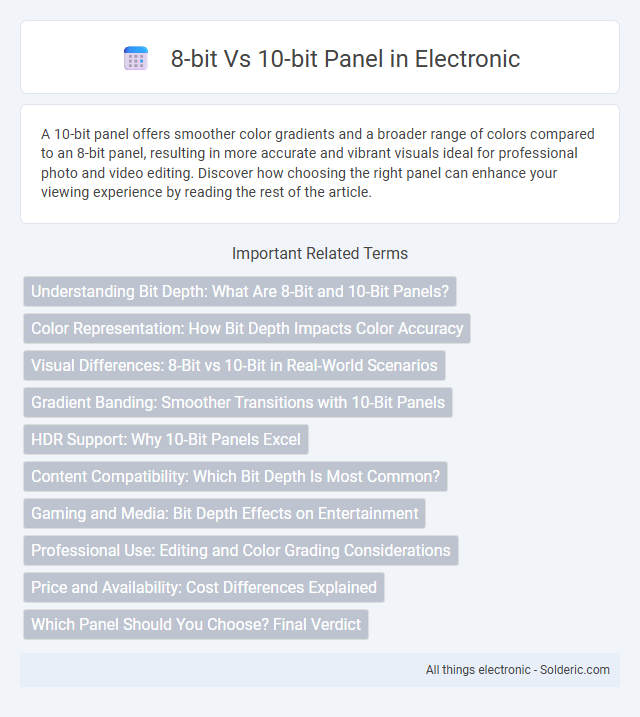A 10-bit panel offers smoother color gradients and a broader range of colors compared to an 8-bit panel, resulting in more accurate and vibrant visuals ideal for professional photo and video editing. Discover how choosing the right panel can enhance your viewing experience by reading the rest of the article.
Comparison Table
| Feature | 8-bit Panel | 10-bit Panel |
|---|---|---|
| Color Depth | 16.7 million colors (2^8 per channel) | 1.07 billion colors (2^10 per channel) |
| Color Accuracy | Standard color precision | Enhanced color precision and gradient smoothness |
| Banding | More prone to visible banding | Reduction in color banding artifacts |
| Use Cases | General computing, gaming, standard multimedia | Professional photo/video editing, HDR content |
| Price | Lower cost | Higher cost due to advanced technology |
| Hardware Support | Widely supported by most graphics cards | Requires compatible GPU and software for full 10-bit output |
Understanding Bit Depth: What Are 8-Bit and 10-Bit Panels?
8-bit panels display 16.7 million colors by processing 256 shades per channel, whereas 10-bit panels can produce over 1 billion colors with 1,024 shades per channel, enabling smoother gradients and reduced color banding. The increased bit depth in 10-bit panels results in more accurate color representation, crucial for professional photo editing, video production, and high-end displays. Devices supporting HDR often rely on 10-bit panels to fully utilize the wider color gamut and enhanced luminance range.
Color Representation: How Bit Depth Impacts Color Accuracy
An 8-bit panel displays 16.7 million colors by representing 256 shades per channel, while a 10-bit panel produces over 1 billion colors with 1,024 shades per channel, ensuring higher color accuracy and smoother gradients. This increased bit depth minimizes color banding and provides more precise color gradations, which is crucial for professional photo and video editing. Your visual experience on a 10-bit panel delivers richer, more lifelike images thanks to its enhanced color representation.
Visual Differences: 8-Bit vs 10-Bit in Real-World Scenarios
A 10-bit panel can display over 1 billion colors, compared to the 16.7 million colors of an 8-bit panel, resulting in smoother gradients and less color banding. In real-world scenarios like photo editing, video production, or HDR content, you'll notice more accurate and vibrant visuals on 10-bit displays. This enhanced color depth is especially important for professionals seeking precise color representation and viewers who demand richer, more immersive experiences.
Gradient Banding: Smoother Transitions with 10-Bit Panels
10-bit panels deliver 1.07 billion colors compared to 16.7 million colors in 8-bit panels, drastically reducing gradient banding and producing smoother color transitions. This improvement is vital for professional photo and video editing where color accuracy and subtle gradations matter. The enhanced bit depth in 10-bit displays minimizes visible steps between shades, ensuring a more seamless and natural visual experience.
HDR Support: Why 10-Bit Panels Excel
10-bit panels support over 1 billion color shades compared to 16.7 million in 8-bit panels, enabling smoother gradients and more precise color accuracy essential for HDR content. This increased color depth allows 10-bit displays to render high dynamic range visuals with enhanced brightness and contrast, resulting in more vibrant and lifelike images. Consequently, 10-bit panels provide superior HDR performance, significantly improving the viewing experience for movies, games, and professional media editing.
Content Compatibility: Which Bit Depth Is Most Common?
8-bit panels are more widely compatible with a majority of current content, as most video streaming platforms, games, and broadcast media primarily use 8-bit color depth. Your device will display smoother gradients and more accurate colors with a 10-bit panel when viewing HDR content or professional-grade videos designed to utilize the extended color range. However, since 10-bit content is less prevalent in everyday media, 8-bit panels remain the most common and practical choice for general use.
Gaming and Media: Bit Depth Effects on Entertainment
8-bit panels display 16.7 million colors, which can cause banding and less smooth gradients in gaming and media content, while 10-bit panels support over 1 billion colors, delivering richer visuals and finer detail. For gaming and multimedia enthusiasts, a 10-bit panel enhances immersion with more accurate color transitions and deeper HDR performance. Your entertainment experience improves significantly with 10-bit displays, especially in content that supports high dynamic range and color depth.
Professional Use: Editing and Color Grading Considerations
10-bit panels deliver over 1 billion colors compared to 16.7 million colors in 8-bit panels, providing smoother gradients and more accurate color representation for professional editing and color grading. This increased color depth reduces banding artifacts and allows for finer adjustments in post-production, essential for maintaining image quality in high-end video and photo workflows. Professionals working with HDR content and color-critical projects benefit significantly from the enhanced precision of 10-bit displays.
Price and Availability: Cost Differences Explained
8-bit panels are typically more affordable and widely available due to lower production costs and simpler manufacturing processes, making them a budget-friendly option for most consumers. In contrast, 10-bit panels offer higher color depth and precision, often found in premium monitors and TVs, which increases their price and limits availability in entry-level markets. Your choice between 8-bit and 10-bit panels will largely depend on budget constraints and the importance of color accuracy in your display needs.
Which Panel Should You Choose? Final Verdict
Choosing between an 8-bit and 10-bit panel depends on your usage needs; 10-bit panels display over 1 billion colors, providing smoother gradients and richer color accuracy ideal for professional photo or video editing. 8-bit panels, capable of displaying 16.7 million colors, are sufficient for general use, casual gaming, and standard multimedia consumption, offering better affordability. Your decision should prioritize color precision and budget, with 10-bit panels delivering superior visual fidelity for creative work and 8-bit panels suitable for everyday tasks.
8-bit vs 10-bit panel Infographic

 solderic.com
solderic.com